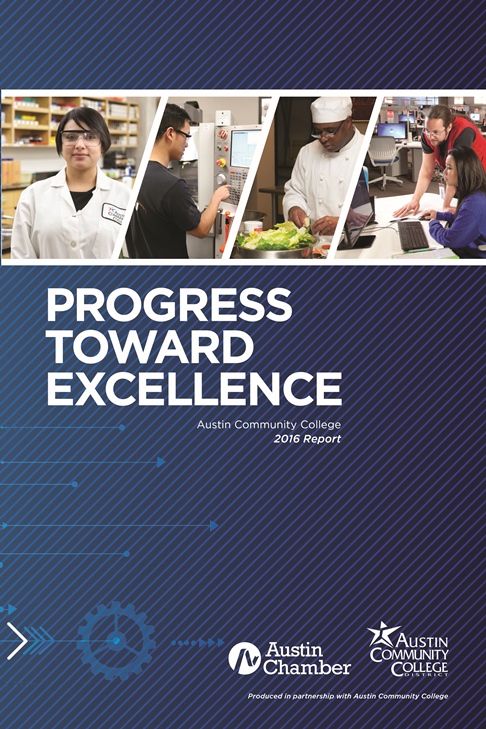 To supply workers for thousands of new middle- and high-skill jobs in Central Texas during the next decade, the Austin Chamber of Commerce and Austin Community College will reinforce a key priority: Draw more individuals to postsecondary education and provide them with flexible, affordable learning options.
To supply workers for thousands of new middle- and high-skill jobs in Central Texas during the next decade, the Austin Chamber of Commerce and Austin Community College will reinforce a key priority: Draw more individuals to postsecondary education and provide them with flexible, affordable learning options.
The just-released 2016 Progress Toward Excellence report, a collaborative effort of ACC and the Austin Chamber, examines how the college is addressing workforce needs and advancing in its goal to become one of the nation’s leading community colleges.
According to projections, Central Texas will need more than 33,000 new and replacement middle skill workers between now and 2022, particularly in sectors such as healthcare, information technology, and advanced manufacturing. As the area’s primary gateway to higher education and training, ACC plays a critical role in building a labor force pipeline and filling workforce gaps.
“Now more than ever, postsecondary education is essential to securing a good-paying job,” says ACC President/CEO Dr. Richard Rhodes. “This is certainly true in the Austin area, where a majority of job openings require a college-level credential.”
“ACC has taken the lead to ensure residents have an accessible, affordable path to higher education and workforce training,” says Mike Perrine, market president of Capital One Bank and chair of the Austin Chamber/ACC Progress Report Task Force. “We commend the college for its efforts to close achievement gaps and ensure more students earn a credential that leads to employment or university transfer.”
In 2015, ACC degree, certificates, and certifications exceeded the projected workforce need, and the college fulfilled 80 percent of the labor force need for workers in applied tech fields. Other findings and developments noted in the report:
- ACC degree, certificate, and other completions increased 71 percent overall from the 2009-10 academic year to 2014-15.
- Enrollment in dual credit and Early College High School (launched in 2011) programs have increased 36 percent and 52 percent respectively.
- Successful completions in developmental reading, writing, and math have increased.
- Enrollment in the college’s Accelerated Programmer Training more than tripled from fall 2013 to fall 2015, with veterans representing about 13 percent of enrolled students, and females making up about 35 percent.
- In the inaugural year of ACC’s first Career Academy, more than 250 high school juniors and seniors enrolled in courses for certified nurse aide, PC technician, and other high-demand occupations.
- “Guided pathways” will make it easier for students to identify a career path and stay on track to completion.
To remain a catalyst for economic growth, Perrine and Rhodes say ACC must provide programs that are relevant and aligned with the region’s needs, and partner with key stakeholders across Central Texas to increase opportunities for students.
“Going forward, ACC will rely on school districts, businesses, and lawmakers to promote a college-going culture, provide internship opportunities, and create policies that are supportive of students pursuing higher education,” Perrine says. “We’re eager to work with ACC to explore ways to ensure we have the talent Central Texas employers need and the workers our residents depend on.”
View the 2016 Progress Toward Excellence report.
Tags: Austin Chamber, Chamber Report, Progress Toward Excellence
Back to Top
